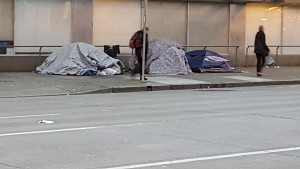On February 17, I interviewed Jonathan Kumar, the lead of GiveSafe, a new nonprofit that helps people give “the moment you see a need.” GiveSafe provides electronic, quarter-sized “beacons” to people who are in need – usually folks asking for money on the street. People who have the GiveSafe app on their phone can read a beacon holder’s story, and donate to that person. The recipient can use that money to buy helpful goods and services like medicine, or make a deposit on an apartment.
Jonathan and I are both members at the Seattle Impact Hub, and I’ve been a volunteer on some of his early testing of GiveSafe.
Several months ago, you mentioned GiveSafe, when it was this very nascent idea, I was like, DO IT! We’ve had several conversations about why people don’t give, even if they’re well meaning – the fear that the money might be used for things like drugs and alcohol, for instance.
I experienced the same thing, and wanted to solve it. One of the most meaningful things for me was observing a man panhandling for 20 minutes and not having success once.
From The Givesafe Facebook Page:
Recently I was at an intersection downtown. I watched a black man, Edward, holding a sign seeking help. It wasn’t raining for once, so I took a break and watched. Perhaps 20 minutes went by. Not a single response..
Eventually, I got up and made my way to him. He was physically imposing, gruffly covered in a ballcap, coats, and tattoos. To an extent, I feared just approaching him. I inquired, “…do you mind if I ask why you think no one’s helping you here? Do you find it to be a lack of cash people have on them, or– ” He interrupted me, “It’s my appearance, my hat, my tattoos. It’s all wrong.”
“You’re saying you come off too physically imposing for people to trust?”
“Yeah.”
“What is it that you’re raising money for?”
Ed told me that inside, he was a diabetic. He couldn’t afford his medication. It was starting to degrade his feet (I would not suggest googling about this), and he wasn’t able to get consistent amounts of meds from local shelters.By his rough exteriors, people gave him a glance, made their guess and kept driving. When I learned the reason he was there, I wanted so badly for people to see what was inside instead. Should they have seen his true need, I know they would’ve responded.
How does GiveSafe work?
The GiveSafe app lets you make cashless, effective giving the moment that you see a need on the street. The app gives you a notification when you pass a person or organization with one of our electronic beacons. The notification will let you know the story of that individual or organization, and will give you a way to respond. If you give to a person through the app, that person can spend the money for goods or services at any business or non-profit registered with GiveSafe.
Basically, we’re creating a product that cuts through all of that nonsense in terms of perceptions of people in need, and gets to the truth of the matter. It shows you what’s really happening, and gives you a very simple way to respond. It facilitates trust.

It seems like this solves some of the information asymmetry that dogs these interactions – givers not really knowing who is in need, and whether receivers will be using the money on something that could harm instead of help them.
I would say that anyone on the street asking for help is truly in need. But yes, the app lends clarity – people can trust that their donation will truly help this person, instead of harming them.
The program also goes a step further. It’s designed to channel beacon-holders into relationships with existing non-profits. That could drive the ultimate outcomes of reducing poverty and homelessness – like returning home to a family, or finding a place to live and a job. The Union Gospel Mission in Pioneer Square, and Facing Homelessness in the U-District, are good examples of relationship-based, rehabilitation-oriented organizations– they are there to walk alongside people. They are focused on individuals as people. They’re not there to judge or push, just to accept and love them no matter what.
With our technology, we will turn all of the beacons off monthly, and to get it reactivated, the beacon-holder will have to check in at one of the relationship-based non-profits. It could just be a walk around the block with someone. We hope that they meet with the same person every month and build a relationship over time. That could lead to housing assistance and job opportunities, or even help in abusive situations or for drug and alcohol rehabilitation. It takes time to develop the intimacy required to share that information with someone.
Our technology can never really create intimacy, but it can help get it started.
Tell me about GiveSafe and data.
The first wave of data goes out to the person who wants to give. He or she can read about a beacon-holder’s need – if that person wants to make it available, wants their story to be known.
When you see someone asking for money on the street, people have to guess at the data – they speculate as to what the facts are, they make a decision, and they keep going. If they guess that there’s no need when there really is one, they can leave the requester at a disadvantage. We think we’ll see more compassion with more information. So that’s the first wave of data that we’re cultivating and transmitting.
The second series of data is on the back end, and helps us analyze how the giving takes place. Where are these encounters happening? What types of people are most likely to give, and how much?
Then, there’s also a layer for non-profits and cities, to help them identify what the needs of the disadvantaged truly are. We’re turning what is now spare change or cash into something that is trackable. You can see, in aggregated data, what disadvantaged peoples’ needs really are, where they spend and what they buy. We can turn cash or spare change into something that is strategic, systemic, can be built upon. That sort of civic information will be of real value.
Finally, not only do givers know that their money will go to effective impactful use, they’ll also be able to watch that gift be put to use. Givers will know if someone uses money for a down payment on an apartment, for a haircut, for medication, or any number of other needs. Givers can also send messages of encouragement to beacon holders through the app.
So when does GiveSafe launch? How can people get involved?
We’ll launch within the next week, with both Android and iPhone apps. The launch will be a minimum viable product. Our effectiveness is based on proximity events, so we have to come up with a way to get a critical mass of both users and beacon holders. We’re releasing the app before we release any beacons – first we want to sign up 500 people within the City of Seattle. That will demonstrate that the city is ready.
Once we hit that threshold, we’ll start distributing beacons for app users to hand out to people in need. They will be able to upload a five-question survey and a photo on behalf of a beacon holder – that information can be as sparse, and a photo as non-identifying, as the beacon holder wants.
If someone wants to support you, what should they do?
Right now, sign up at WithGiveSafe.org. Then you’ll get a message when the app is live and you can help us get to 500 users.
If you want to contribute in other ways way, you can donate to a general beacon holder fund – the money will get spread over all beacon holders. You can donate to us directly, to help us get the project off the ground. You could volunteer to request the participation of local businesses, or you can volunteer to become a distributor of beacons as well.
What’s the best way to contact you?
You can also follow our Facebook page, or you can email me at inquiries@withgivesafe.org

